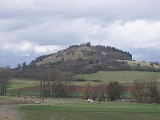
Wartberg culture
Encyclopedia
The Wartberg culture sometimes: Wartberg group (Wartberggruppe) or Collared bottle culture (Kragenflaschenkultur) is a prehistoric
culture
of the later Central Europe
an Neolithic
. It is named after its type site
, the Wartberg, a hill (306m asl
) near Niedenstein
-Kirchberg in northern Hesse
, Germany
.
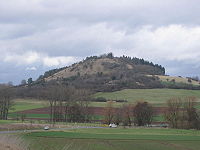 The Wartberg culture is currently known to have a distribution in northern Hesse, southern Lower Saxony
The Wartberg culture is currently known to have a distribution in northern Hesse, southern Lower Saxony
and western Thuringia
; a southern extent as far as the Rhein-Main Region is possible, but not definitely proven at this point.
. The Corded Ware and Single Grave cultures
succeed it.

(all of the above are located on basalt outcrops in the fertile Fritzlar
basin), and from the Calden
earthwork
enclosure
. Nearly all settlements identified so far are in hilltop locations: an enclosed site at Wittelsberg near Amöneburg
is an exception. Virtually all the known settlements appear to have come into existence several hundred years after the development of Wartberg pottery (see below); early Wartberg settlement activity remains mostly unknown as yet.
Finds from the Wartberg and its sister sites included fragmented bones, mainly of cattle
, pig
, sheep/goat
and deer
, but also of other wild animals, like bear
or beaver
; human bone fragments also occur in some of the settlements. Originally, the Wartberg (first excavated in the later 19th century) was interpreted as a cult
place, but the remains of coarse handmade pottery and of mud wall cladding do suggest settlement activity.
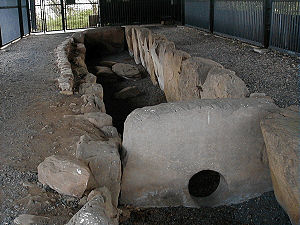 Wartberg material is also found in a number of gallery grave
Wartberg material is also found in a number of gallery grave
s (a type of megalithic tomb). Their connection with the Wartberg settlements was only recognised in the 1960s and 1970s, thus the tombs are sometimes treated separately as the Hessian-Westphalian stone cist group (Hessisch-Westfälische Steinkistengruppe).
These include the tombs at Züschen
near Fritzlar
, at Lohra
, at Naumburg
-Altendorf
, at Hadamar
-Niederzeuzheim (now rebuilt in a park at Hachenburg
), at Beselich
-Niedertiefenbach
, at Warburg
, Rimbeck and at Grossenrode, as well as two tombs near the Calden enclosure. A tomb at Muschenheim near Münzenberg
may also belong to the same type, as may a further one at Bad Vilbel
near Frankfurt am Main which was destroyed after 1945.
The best known of these tombs are those of Züschen, Lohra, Niederzeuzzheim and Altendorf. They normally contained the inhumed remains of multiple individuals (the Altendorf tomb contained at least 250 people) of all ages and both sexes. Lohra is an exception insofar as there the dead were cremated
. Gravegoods are scarce but include pottery (collared bottles), stone tools and animal bones, especially the jawbones of foxes, which may have played a totem
ic role. The Züschen tomb is also remarkable for the presence of rock art
.
Some of the tombs can be directly associated with nearby hilltop sites or settlements, that is, the Züschen tomb with the Hasenberg and the Calden tombs with the earthwork. According to the German archaeologist Waltraud Schrickel, the association with gallery graves suggests a west European influence, perhaps from the Paris basin
in France
, where very similar tombs occur. The Wartberg tombs appear to start developing around 3400 BC, earlier than most of the known settlements.
s occurs in northern Hesse and west Thuringia. Although their dates are unknown, their geographic spread appears to coincide with that of Wartberg material, perhaps suggesting a connection.
, was built around 3700 BC. It is an irregular enclosure of two ditches and a palisade, encompassing an area of 14 hectares. The enclosure has five openings, perhaps comparable to British
Causewayed enclosure
s. Although it can with some certainty be seen as derived from the Michelsberg tradition, material associated with its early phases suggests a close connectionn with early Wartberg. It appears to have been a tradition for several centuries to bury animal bones (food refuse?) and broken pots in pits dug into the partially filled-in earthwork ditches. The ditches also contain the remains of many human inhumations. This activity continued until circa 2000 BC and was particularly intensive during the Wartberg period. Two nearby graves postdate the earthwork by several centuries, but coincide with that activity. While the original function of the earthwork is not necessarily explained by these finds, it appears likely that at least during later phases of its use it had a ritual
significance, perhaps connected with a cult of the dead.
In contrast, the enclosure around the settlement at Wittelsberg appears to be simply protective/defensive in nature.
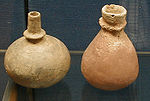
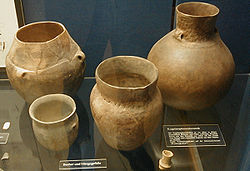
of Central Germany.
In the later Wartberg, strap-handled cups, funnel beakers, varied bowls, large pots with holes below the rim and collared bottles occur. The frequent presence of collared bottles, not least in the tombs, is of special interest. The bottles are made with somewhat more care than other vessels; their very specific shape suggests a special function, often suggested to be connected with the storage of special material, like vegetable oil or sulphur, perhaps for healing purposes.
A variety of bone tools, mainly points, has been found both in tombs and settlements.
society susbsisting from agriculture
and animal husbandry
, but hunting
may play a considerable economic role. The Wartberg area appears to be in general trade contact with its neighbouring regions.
Prehistory
Prehistory is the span of time before recorded history. Prehistory can refer to the period of human existence before the availability of those written records with which recorded history begins. More broadly, it refers to all the time preceding human existence and the invention of writing...
culture
Archaeological culture
An archaeological culture is a recurring assemblage of artifacts from a specific time and place, which are thought to constitute the material culture remains of a particular past human society. The connection between the artifacts is based on archaeologists' understanding and interpretation and...
of the later Central Europe
Central Europe
Central Europe or alternatively Middle Europe is a region of the European continent lying between the variously defined areas of Eastern and Western Europe...
an Neolithic
Neolithic
The Neolithic Age, Era, or Period, or New Stone Age, was a period in the development of human technology, beginning about 9500 BC in some parts of the Middle East, and later in other parts of the world. It is traditionally considered as the last part of the Stone Age...
. It is named after its type site
Type site
In archaeology a type site is a site that is considered the model of a particular archaeological culture...
, the Wartberg, a hill (306m asl
Above mean sea level
The term above mean sea level refers to the elevation or altitude of any object, relative to the average sea level datum. AMSL is used extensively in radio by engineers to determine the coverage area a station will be able to reach...
) near Niedenstein
Niedenstein
Niedenstein is a small town and an officially recognized climatic spa in the Schwalm-Eder district in northern Hesse, Germany.-Location:Niedenstein's main town lies in the southeast of the Habichtswald Nature Park right on the western slope of the Langenberge, a low mountain range reaching 557 m...
-Kirchberg in northern Hesse
Hesse
Hesse or Hessia is both a cultural region of Germany and the name of an individual German state.* The cultural region of Hesse includes both the State of Hesse and the area known as Rhenish Hesse in the neighbouring Rhineland-Palatinate state...
, Germany
Germany
Germany , officially the Federal Republic of Germany , is a federal parliamentary republic in Europe. The country consists of 16 states while the capital and largest city is Berlin. Germany covers an area of 357,021 km2 and has a largely temperate seasonal climate...
.
Distribution

Lower Saxony
Lower Saxony is a German state situated in north-western Germany and is second in area and fourth in population among the sixteen states of Germany...
and western Thuringia
Thuringia
The Free State of Thuringia is a state of Germany, located in the central part of the country.It has an area of and 2.29 million inhabitants, making it the sixth smallest by area and the fifth smallest by population of Germany's sixteen states....
; a southern extent as far as the Rhein-Main Region is possible, but not definitely proven at this point.
Dates
The term Wartberg culture describes a group of sites with similar characteristic finds from circa 3600-2800 BC. The Wartberg culture appears to be a regional development derived from Michelsberg and Baalberge culture antecedents. It is contemporary, and in contact, with Bernburg culture and Funnel Beaker (TRB)Funnelbeaker culture
The Funnelbeaker culture, short TRB from Trichterbecherkultur is the principal north central European megalithic culture of late Neolithic Europe.- Predecessor and successor cultures :...
. The Corded Ware and Single Grave cultures
Corded Ware culture
The Corded Ware culture , alternatively characterized as the Battle Axe culture or Single Grave culture, is an enormous European archaeological horizon that begins in the late Neolithic , flourishes through the Copper Age and culminates in the early Bronze Age.Corded Ware culture is associated with...
succeed it.
Sites

Settlements
Its best known sites are Wartberg, near Kirchberg, Hasenberg, a hill near Lohne, as well as Güntersberg and Bürgel, hills near GudensbergGudensberg
Gudensberg is a small town in northern Hesse, Germany. Since municipal reform in 1974, the nearby villages of Deute, Dissen, Dorla, Gleichen, Maden and Obervorschütz have been parts of the municipality.-Geography:...
(all of the above are located on basalt outcrops in the fertile Fritzlar
Fritzlar
Fritzlar is a small German town in the Schwalm-Eder district in northern Hesse, north of Frankfurt, with a storied history. It can reasonably be argued that the town is the site where the Christianization of northern Germany began and the birthplace of the German empire as a political entity.The...
basin), and from the Calden
Calden
Calden is a municipality in the district of Kassel, in Hesse, Germany. It is situated 12 kilometers northwest of Kassel.- References :...
earthwork
Earthworks (archaeology)
In archaeology, earthwork is a general term to describe artificial changes in land level. Earthworks are often known colloquially as 'lumps and bumps'. Earthworks can themselves be archaeological features or they can show features beneath the surface...
enclosure
Enclosure (archaeology)
In archaeology, an enclosure is one of the most common types of archaeological site. It is any area of land separated from surrounding land by earthworks, walls or fencing. Such a simple feature is found all over the world and during almost all archaeological periods...
. Nearly all settlements identified so far are in hilltop locations: an enclosed site at Wittelsberg near Amöneburg
Amöneburg
Amöneburg is a town in the Marburg-Biedenkopf district in Hesse, Germany. It lies on a mountain and is built around the castle of the same name, Burg Amöneburg.- Location :...
is an exception. Virtually all the known settlements appear to have come into existence several hundred years after the development of Wartberg pottery (see below); early Wartberg settlement activity remains mostly unknown as yet.
Finds from the Wartberg and its sister sites included fragmented bones, mainly of cattle
Cattle
Cattle are the most common type of large domesticated ungulates. They are a prominent modern member of the subfamily Bovinae, are the most widespread species of the genus Bos, and are most commonly classified collectively as Bos primigenius...
, pig
Pig
A pig is any of the animals in the genus Sus, within the Suidae family of even-toed ungulates. Pigs include the domestic pig, its ancestor the wild boar, and several other wild relatives...
, sheep/goat
Goat
The domestic goat is a subspecies of goat domesticated from the wild goat of southwest Asia and Eastern Europe. The goat is a member of the Bovidae family and is closely related to the sheep as both are in the goat-antelope subfamily Caprinae. There are over three hundred distinct breeds of...
and deer
Deer
Deer are the ruminant mammals forming the family Cervidae. Species in the Cervidae family include white-tailed deer, elk, moose, red deer, reindeer, fallow deer, roe deer and chital. Male deer of all species and female reindeer grow and shed new antlers each year...
, but also of other wild animals, like bear
Bear
Bears are mammals of the family Ursidae. Bears are classified as caniforms, or doglike carnivorans, with the pinnipeds being their closest living relatives. Although there are only eight living species of bear, they are widespread, appearing in a wide variety of habitats throughout the Northern...
or beaver
Beaver
The beaver is a primarily nocturnal, large, semi-aquatic rodent. Castor includes two extant species, North American Beaver and Eurasian Beaver . Beavers are known for building dams, canals, and lodges . They are the second-largest rodent in the world...
; human bone fragments also occur in some of the settlements. Originally, the Wartberg (first excavated in the later 19th century) was interpreted as a cult
Cult
The word cult in current popular usage usually refers to a group whose beliefs or practices are considered abnormal or bizarre. The word originally denoted a system of ritual practices...
place, but the remains of coarse handmade pottery and of mud wall cladding do suggest settlement activity.
Megalithic tombs

Gallery grave
A Gallery grave is a form of Megalithic tomb where there is no size difference between the burial chamber itself and the entrance passage. Two parallel walls of stone slabs were erected to form a corridor and covered with a line of capstones. The rectangular tomb was covered with a barrow or a cairn...
s (a type of megalithic tomb). Their connection with the Wartberg settlements was only recognised in the 1960s and 1970s, thus the tombs are sometimes treated separately as the Hessian-Westphalian stone cist group (Hessisch-Westfälische Steinkistengruppe).
These include the tombs at Züschen
Züschen (megalithic tomb)
The Züschen tomb is a prehistoric burial monument, located between Lohne and Züschen, near Fritzlar, Hesse, Germany. Classified as a gallery grave or a Hessian-Westphalian stone cist , it is one of the most important megalithic monuments in Central Europe...
near Fritzlar
Fritzlar
Fritzlar is a small German town in the Schwalm-Eder district in northern Hesse, north of Frankfurt, with a storied history. It can reasonably be argued that the town is the site where the Christianization of northern Germany began and the birthplace of the German empire as a political entity.The...
, at Lohra
Lohra (megalithic tomb)
The Lohra tomb was a megalithic monument outside Lohra near Marburg in north central Hesse, Germany. It is one of the lesser known among its type in Central Europe. It dates to the late Neolithic, probably just after 3000 BC...
, at Naumburg
Naumburg, Hesse
Naumburg is a town in the district of Kassel, in Hesse, Germany. It is located 25 km southwest of Kassel on the German Framework Road.-External links:*...
-Altendorf
Altendorf (megalithic tomb)
The Altendorf tomb was an important megalithic tomb at Altenburg near Naumburg, northern Hesse, Germany. It was a gallery grave belonging to the Late Neolithic Wartberg culture...
, at Hadamar
Hadamar
Hadamar is a small town in Limburg-Weilburg district in Hesse, Germany.Hadamar is known for its Clinic for Forensic Psychiatry/Centre for Social Psychiatry, lying at the edge of town, in whose outlying buildings is also found the Hadamar Memorial...
-Niederzeuzheim (now rebuilt in a park at Hachenburg
Hachenburg
-Geography:The town lies in the Westerwald between Koblenz and Siegen, roughly 10 km west of Bad Marienberg on the river Nister. Hachenburg is the administrative seat of the Verbandsgemeinde of Hachenburg, a kind of collective municipality .-The castle and the town:The castle , former seat of...
), at Beselich
Beselich
- Location :Beselich lies on the northeast edge of the Limburg Basin , on the edge of the Lahn valley, on the southeast slope of the Westerwald 220 m above sea level. Visible from far away is the Beselicher Kopf . The brooks Tiefenbach, Kerkerbach and Brandbach flow through the municipal area...
-Niedertiefenbach
Niedertiefenbach (megalithic tomb)
The Niedertiefenbach tomb is a megalithic tomb located near Beselich-Niedertiefebach in Hesse, Germany. It belongs to the Wartberg culture of the Central European Later Neolithic...
, at Warburg
Warburg
Warburg is a town in eastern North Rhine-Westphalia on the river Diemel near the three-state point shared by Hessen, Lower Saxony and North Rhine-Westphalia. It is in Höxter district and Detmold region...
, Rimbeck and at Grossenrode, as well as two tombs near the Calden enclosure. A tomb at Muschenheim near Münzenberg
Münzenberg
Münzenberg is a town in the Wetteraukreis district in Hesse, Germany. It is located 13 km north of Friedberg, and 16 km southeast of Gießen. The castle of Münzenberg is in the town....
may also belong to the same type, as may a further one at Bad Vilbel
Bad Vilbel
Bad Vilbel is a spa town with many mineral waters. Bad Vilbel is the town with the most inhabitants in the Wetteraukreis district in Hessen, Germany. The city center of Bad Vilbel is located 8 km northeast of the center of Frankfurt am Main...
near Frankfurt am Main which was destroyed after 1945.
The best known of these tombs are those of Züschen, Lohra, Niederzeuzzheim and Altendorf. They normally contained the inhumed remains of multiple individuals (the Altendorf tomb contained at least 250 people) of all ages and both sexes. Lohra is an exception insofar as there the dead were cremated
Cremation
Cremation is the process of reducing bodies to basic chemical compounds such as gasses and bone fragments. This is accomplished through high-temperature burning, vaporization and oxidation....
. Gravegoods are scarce but include pottery (collared bottles), stone tools and animal bones, especially the jawbones of foxes, which may have played a totem
Totem
A totem is a stipulated ancestor of a group of people, such as a family, clan, group, lineage, or tribe.Totems support larger groups than the individual person. In kinship and descent, if the apical ancestor of a clan is nonhuman, it is called a totem...
ic role. The Züschen tomb is also remarkable for the presence of rock art
Rock art
Rock art is a term used in archaeology for any human-made markings made on natural stone. They can be divided into:*Petroglyphs - carvings into stone surfaces*Pictographs - rock and cave paintings...
.
Some of the tombs can be directly associated with nearby hilltop sites or settlements, that is, the Züschen tomb with the Hasenberg and the Calden tombs with the earthwork. According to the German archaeologist Waltraud Schrickel, the association with gallery graves suggests a west European influence, perhaps from the Paris basin
Paris Basin
Paris Basin may refer to:*As a hydrological basin, it is largely the basin of the River Seine* Paris Basin , the geological basin...
in France
France
The French Republic , The French Republic , The French Republic , (commonly known as France , is a unitary semi-presidential republic in Western Europe with several overseas territories and islands located on other continents and in the Indian, Pacific, and Atlantic oceans. Metropolitan France...
, where very similar tombs occur. The Wartberg tombs appear to start developing around 3400 BC, earlier than most of the known settlements.
Standing stones
A loose distribution of standing stoneStanding stone
Standing stones, orthostats, liths, or more commonly megaliths are solitary stones set vertically in the ground and come in many different varieties....
s occurs in northern Hesse and west Thuringia. Although their dates are unknown, their geographic spread appears to coincide with that of Wartberg material, perhaps suggesting a connection.
Enclosures
The Calden earthwork, a large enclosure northwest of modern KasselKassel
Kassel is a town located on the Fulda River in northern Hesse, Germany. It is the administrative seat of the Kassel Regierungsbezirk and the Kreis of the same name and has approximately 195,000 inhabitants.- History :...
, was built around 3700 BC. It is an irregular enclosure of two ditches and a palisade, encompassing an area of 14 hectares. The enclosure has five openings, perhaps comparable to British
United Kingdom
The United Kingdom of Great Britain and Northern IrelandIn the United Kingdom and Dependencies, other languages have been officially recognised as legitimate autochthonous languages under the European Charter for Regional or Minority Languages...
Causewayed enclosure
Causewayed enclosure
A causewayed enclosure is a type of large prehistoric earthwork common to the early Neolithic in Europe. More than 100 examples are recorded in France and 70 in England, while further sites are known in Scandinavia, Belgium, Germany, Italy, Ireland and Slovakia.The term "causewayed enclosure" is...
s. Although it can with some certainty be seen as derived from the Michelsberg tradition, material associated with its early phases suggests a close connectionn with early Wartberg. It appears to have been a tradition for several centuries to bury animal bones (food refuse?) and broken pots in pits dug into the partially filled-in earthwork ditches. The ditches also contain the remains of many human inhumations. This activity continued until circa 2000 BC and was particularly intensive during the Wartberg period. Two nearby graves postdate the earthwork by several centuries, but coincide with that activity. While the original function of the earthwork is not necessarily explained by these finds, it appears likely that at least during later phases of its use it had a ritual
Ritual
A ritual is a set of actions, performed mainly for their symbolic value. It may be prescribed by a religion or by the traditions of a community. The term usually excludes actions which are arbitrarily chosen by the performers....
significance, perhaps connected with a cult of the dead.
In contrast, the enclosure around the settlement at Wittelsberg appears to be simply protective/defensive in nature.
Finds


Pottery
Wartberg pottery is handmade and mostly very coarse. Typical shapes in the mid-4th millennium include saucepans with inturned rim and deep incisions, cups with strap handles, collared bottles (Kragenflaschen). The presence of pottery with deeply incised patterns as well as of clay drums suggest connections with the Funnel Beaker culture (TRB)Funnelbeaker culture
The Funnelbeaker culture, short TRB from Trichterbecherkultur is the principal north central European megalithic culture of late Neolithic Europe.- Predecessor and successor cultures :...
of Central Germany.
In the later Wartberg, strap-handled cups, funnel beakers, varied bowls, large pots with holes below the rim and collared bottles occur. The frequent presence of collared bottles, not least in the tombs, is of special interest. The bottles are made with somewhat more care than other vessels; their very specific shape suggests a special function, often suggested to be connected with the storage of special material, like vegetable oil or sulphur, perhaps for healing purposes.
Stone and bone tools
Slate axes are very common, slate blades also occur. The Wartberg culture produced fine stone arrowheads with well defined tangs and "wings".A variety of bone tools, mainly points, has been found both in tombs and settlements.
Economy
Little can be said about the economy of the Wartberg group. The location of sites and certain finds suggest a broadly sedentarySedentism
In evolutionary anthropology and archaeology, sedentism , is a term applied to the transition from nomadic to permanent, year-round settlement.- Requirements for permanent settlements :...
society susbsisting from agriculture
Agriculture
Agriculture is the cultivation of animals, plants, fungi and other life forms for food, fiber, and other products used to sustain life. Agriculture was the key implement in the rise of sedentary human civilization, whereby farming of domesticated species created food surpluses that nurtured the...
and animal husbandry
Animal husbandry
Animal husbandry is the agricultural practice of breeding and raising livestock.- History :Animal husbandry has been practiced for thousands of years, since the first domestication of animals....
, but hunting
Hunting
Hunting is the practice of pursuing any living thing, usually wildlife, for food, recreation, or trade. In present-day use, the term refers to lawful hunting, as distinguished from poaching, which is the killing, trapping or capture of the hunted species contrary to applicable law...
may play a considerable economic role. The Wartberg area appears to be in general trade contact with its neighbouring regions.
Social aspects
The presence of earthworks and of collective tombs indicates different levels of collective effort, thus implying a considerable degree of social organisation.Museums
Wartberg material is on display at the following museums:- Hessian State Museum (Hessisches Landesmuseum), KasselKasselKassel is a town located on the Fulda River in northern Hesse, Germany. It is the administrative seat of the Kassel Regierungsbezirk and the Kreis of the same name and has approximately 195,000 inhabitants.- History :...
- Heimatmuseum FritzlarFritzlarFritzlar is a small German town in the Schwalm-Eder district in northern Hesse, north of Frankfurt, with a storied history. It can reasonably be argued that the town is the site where the Christianization of northern Germany began and the birthplace of the German empire as a political entity.The...
See also
- Züschen (megalithic tomb)Züschen (megalithic tomb)The Züschen tomb is a prehistoric burial monument, located between Lohne and Züschen, near Fritzlar, Hesse, Germany. Classified as a gallery grave or a Hessian-Westphalian stone cist , it is one of the most important megalithic monuments in Central Europe...
- Lohra (megalithic tomb)Lohra (megalithic tomb)The Lohra tomb was a megalithic monument outside Lohra near Marburg in north central Hesse, Germany. It is one of the lesser known among its type in Central Europe. It dates to the late Neolithic, probably just after 3000 BC...
- Altendorf (megalithic tomb)Altendorf (megalithic tomb)The Altendorf tomb was an important megalithic tomb at Altenburg near Naumburg, northern Hesse, Germany. It was a gallery grave belonging to the Late Neolithic Wartberg culture...
- Niedertiefenbach (megalithic tomb)Niedertiefenbach (megalithic tomb)The Niedertiefenbach tomb is a megalithic tomb located near Beselich-Niedertiefebach in Hesse, Germany. It belongs to the Wartberg culture of the Central European Later Neolithic...

